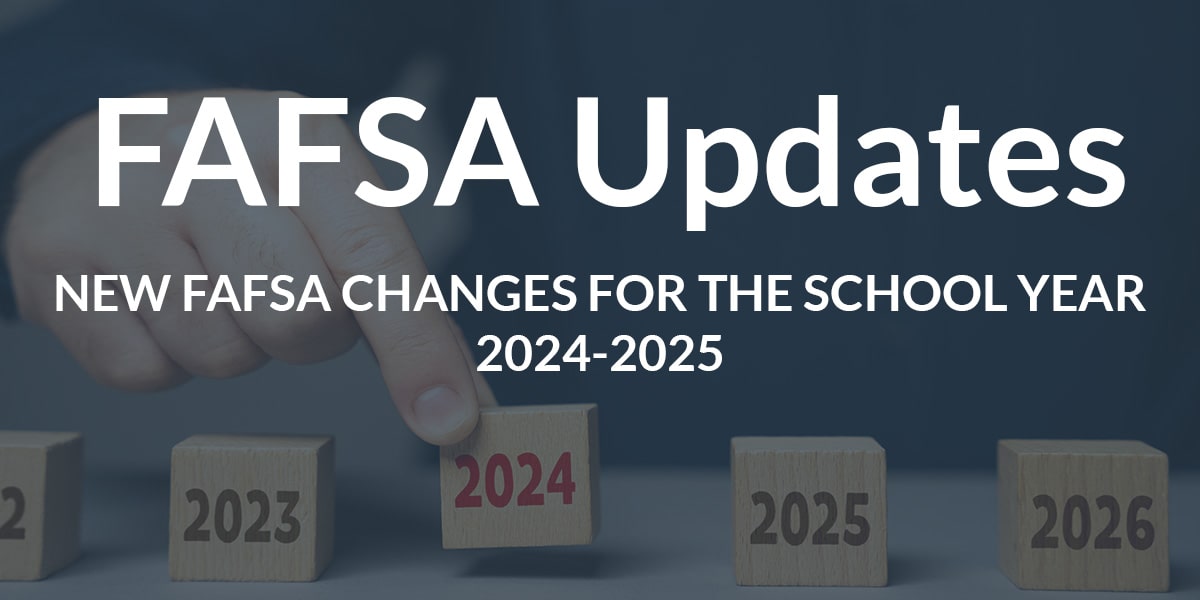NEW FAFSA CHANGES FOR THE SCHOOL YEAR 2024-2025

The Free Application for Federal Student Aid (FAFSA) is set to undergo significant revisions. Certified College Funding Specialists and families need to be informed about these impending changes. Congress passed the FAFSA Simplification Act as part of the 2021 pandemic relief appropriations bill, slated to take effect in the 2024-2025 school year.
The goal is to simplify the federal student aid application process, marking a major overhaul of the systems and processes currently in place. This affects the FAFSA® form and shifts the need analysis formula from RFC to the Student Aid Index (SAI).
Summary of FAFSA Changes:
FAFSA Simplification:
The most notable change involves the FAFSA application form. The existing 2023-2024 FAFSA form, which consists of 100 questions and began its filing on October 1, 2022, will be trimmed down to 36 questions. The filing for the 2024-2025 FAFSA year will commence in December 2023 and subsequently on October 1st every following year.
In a bid to streamline the financial aid application, it will now align more closely with the IRS’s income tax regulations. Students, spouses, parents, and stepparents will be required to give their consent to share their Federal Tax Information (FTI) in the new "Consent to Retrieve and Disclose Federal Tax Information" section to determine federal student aid eligibility.
The current IRS Data Retrieval Tool (DRT) will be replaced with a direct data share with the IRS.
If any contributor opts out of giving their consent on the FAFSA form, the form can still be submitted, but the SAI won't be calculated.
Elimination of the Expected Family Contribution (EFC):
The new rules will phase out the term "Expected Family Contribution (EFC)" from the financial aid application. Previously, the EFC was used to estimate the amount a family was expected to contribute for a year of college. It will now be supplanted by the Student Aid Index (SAI), which will serve as an "eligibility index" for distributing financial aid, excluding the exact dollar amount a family can contribute towards college expenses.
The SAI will determine eligibility for all Title IV student aid, with the exception of the maximum and minimum Pell Grant awards. Pell Grants will now be ascertained based on the number of parents in the student's household and the family income relative to the federal poverty level, based on household size. This shift will introduce a look-up table, enabling families to gauge potential Pell Grant eligibility well ahead of college application.
Multiple Children in College:
The updated SAI formula will no longer provide families with multiple college-going children a significant financial aid advantage. Under current rules, parents with more than one child enrolled in college simultaneously see their EFC slashed by nearly 50% per child. This benefit will be discontinued in the new formula.
Income Protection Allowance:
The SAI formula will exclude state and other tax income and will amplify the parental income protection allowance (IPA) by approximately 20%. This allowance will now solely depend on the number of household members. The student income protection allowance, which stands at $7,600 for 2023-2024, is set to rise to $9,410 for 2024-2025. This amendment will significantly lower the SAI for dependent students.
Assets:
The income threshold, which determines if an applicant can avoid reporting assets under the simplified financial aid formula, will be raised by $10,000, moving from $49,999 to $59,999. The new SAI formula will also do away with exclusions for family farm and small business assets. This means families will need to declare the net value of businesses or farms they own unless they qualify under the new threshold that exempts asset considerations.
Divorced and Separated Families:
For divorced or separated parents, the parent with whom the student has spent more than half of the school year is currently responsible for filing the FAFSA application. For instance, if the FAFSA is submitted in December 2023 for the academic year 2024-2025, it would consider the child's living arrangements in 2022. A common strategy has been for the student to reside with the lesser-earning parent during this reference year. However, under the updated rules for 2024-2025, the parent claiming the child on their 2022 tax return (indicating they provide the majority of the child's financial support) will be tasked with completing the FAFSA.
Child Support:
In the new SAI formula, received child support won't be classified as untaxed income but will be added to parental assets.
Grandparent Giving:
The revamped FAFSA will simplify contributions from grandparents or others outside the immediate family towards college expenses without affecting the family’s financial aid status. Any financial support from grandparents or others won't be considered in the FAFSA, eliminating the current question about it.
At present, monetary help from grandparents, aunts, uncles, friends, or others outside the immediate family is viewed as the student's untaxed income and can be taxed up to 50% by the EFC formula. For instance, funds from a grandparent-owned 529 plan will no longer be considered income for the student (as per the current FAFSA question 44i).
Conclusion about the FAFSA:
The complexities of the FAFSA and CSS Profile have long perplexed parents nationwide, many of whom navigate college payments without fully grasping these intricate aid forms. Assisting clients in understanding these forthcoming FAFSA modifications can help them sidestep costly errors and ensure students attend the right college at the most affordable rate.
Posted by Ron Them
He is a former Chief Financial Officer of a Fortune 500 company and currently owns his own financial advisory company specializing in cash flow planning for business owners and executives. He developed the Cash Flow Recovery™ process that uses cash flow management principals to increase asset value and build wealth for business owners.
He is also the originator of several software calculators to help advisors and families make college affordable, including:
* College QuikPlan EFC Calculator
* "Find the Money" College Cash Flow Calculator
* College Debt Reduction Calculator
Ron has been quoted in U.S. News and World Report, Kiplinger's Personal Finance, Smart Money, Financial Advisor Magazine, Small Firm Profit Report, Practical Accountant, LIMRA's Market Facts, Senior Advisors Magazine, HR Magazine, BenefitNews.com, Employee Benefit News Magazine, ProducersWeb.com, Entrepreneur Magazine, Insurance Selling Magazine, CollegeNews.com, The Christian Voice, and Columbus CEO Magazine.
